A History of Thai Banknotes: 2nd Series
Welcome to our second article of A History of Thai Banknotes. Today we'll be exploring the 2nd Series of banknotes that were printed and used from 1925 to 1934, but expect some surprises on the way. These notes are quite scarce (Type II being the most common) and even more rare in good condition. They have been printed during the reign of Rama VI and Rama VII (Prajadhipok)
In 1923, Thomas De La Rue & Company Limited won a bid to print more banknotes for Siam after competing with several printing companies such as Bradbury Wilkinson & Company, Waterlow & Sons and American Bank Note Company.
Each company had to submit an artwork bid to the Ministry of Finance. Bradbury Wilkinson & Company had submitted trial designs that had been rejected, because they contained a portrait of Rama VI (Vajiravudh) as he did not give permission to use his image on banknotes, but he did consent to use it on stamps and coins.
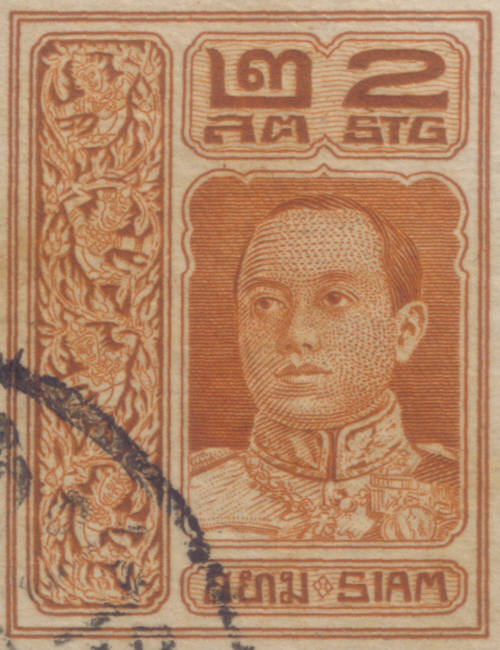
What Vajiravudh's portrait would have looked like if it was used on a banknote.
The approval of the new designs for the Second Series was conducted in Bangkok by the Minister of Finance, His Highness Prince Subhayok Kasem. In a correspondence dated 30th October 1924 from the Ministry of Finance to TdlR, the Minister conveyed his approval of all values based on the photographic prints submitted by TdlR on 17th September. These prints included the floral designs that had been previously discussed, now featured in six of the twelve rays. There were some typographical errors in the designations, which needed correction. Once these errors were rectified, the proofs of the specimen banknotes were to be presented to the Minister in London for final approval. Upon receiving the approved designs back from TdlR, the printing process could commence.
The 1 Baht Second Series, Type I, was announced and put into circulation on July 21, 1925. The announcement of the 5, 10, and 20 Baht was made on February 18, 1926. The announcement of the 100 Baht came on November 19, 1928.On July 15, 1928, the 1000 Baht was also announced.
The design featured printing on both sides. The front displayed a guilloche pattern at the center, radiating twelve rays, while the reverse showcased an image of the Royal Ploughing Ceremony. This particular banknote was referred to as the "Ploughing Ceremony Note." It was issued in six denominations: 1, 5, 10, 20, 100, and 1000 baht. Each denomination was available in two variations. The Type I banknotes, marked with the inscription "Government of Siam" in Thai, featured the phrase "Promise to pay the bearer on demand in Siamese Currency." Both Series I and II included an illustration of the Royal Ploughing Ceremony on their reverse side.

The text used on Type I (สัญญาจะจ่ายเงินให้แก่ผู้นำธนบัตรนี้มาขึ้นเป็นเงินตราสยาม)
As detailed in the publication "CENTENARY OF THAI BANKNOTES: 1902-2002" by the Bank of Thailand, the Currency Act of 1928, enacted on April 15, 1928, established that the nation's currency comprised both banknotes and coins, with the monetary units being Baht and Satang. Article 9 of this Act declared that banknotes and coins were recognized as legal tender without limitation, leading to a modification of the inscription on banknotes to read: "This note is legal tender in accordance with the law."

The text used in Type II (ธนบัตร์เป็นเงินที่ชำระหนี้ได้ตามกฎหมาย)
In 1928, Thomas de la Rue & Co. Ltd, based in London, was tasked with updating the banknote inscription from "Promise to pay the bearer on demand in Siamese Currency" to "This note is legal tender in accordance with the law.”
These banknotes were printed up until 1934. They are known to be the first series to incorporate the use of the three-headed elephant into the guilloche, which is used in all future series printed by TdlR. While I find the design a huge improvement over Series 1, I do wish for use of more imagery. The lack of watermarks may be concerning when you want to assure the genuineness of the notes, but don't worry. There are secret marks to be found across all notes to prevent forging, an unusual technique suggested by the Minister of Finance. The use of secret marks can prove to be a problem in detecting forged notes, but nonetheless it has proved to be successful.
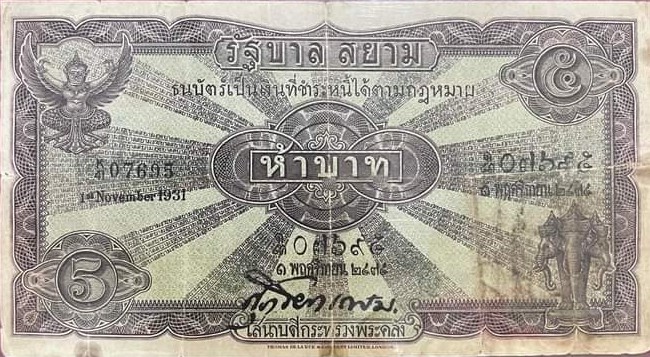
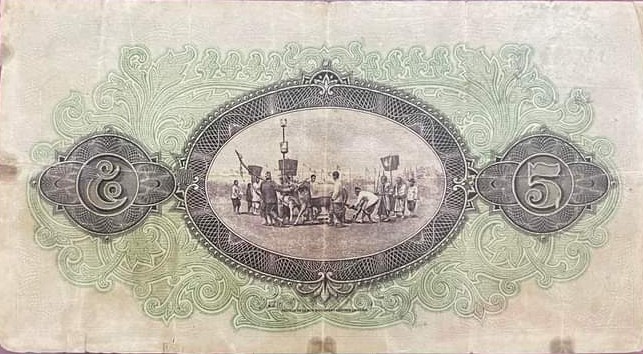




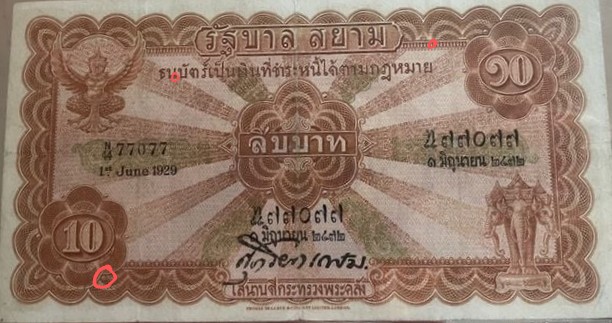
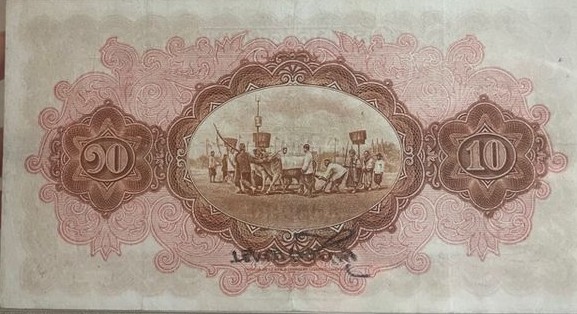
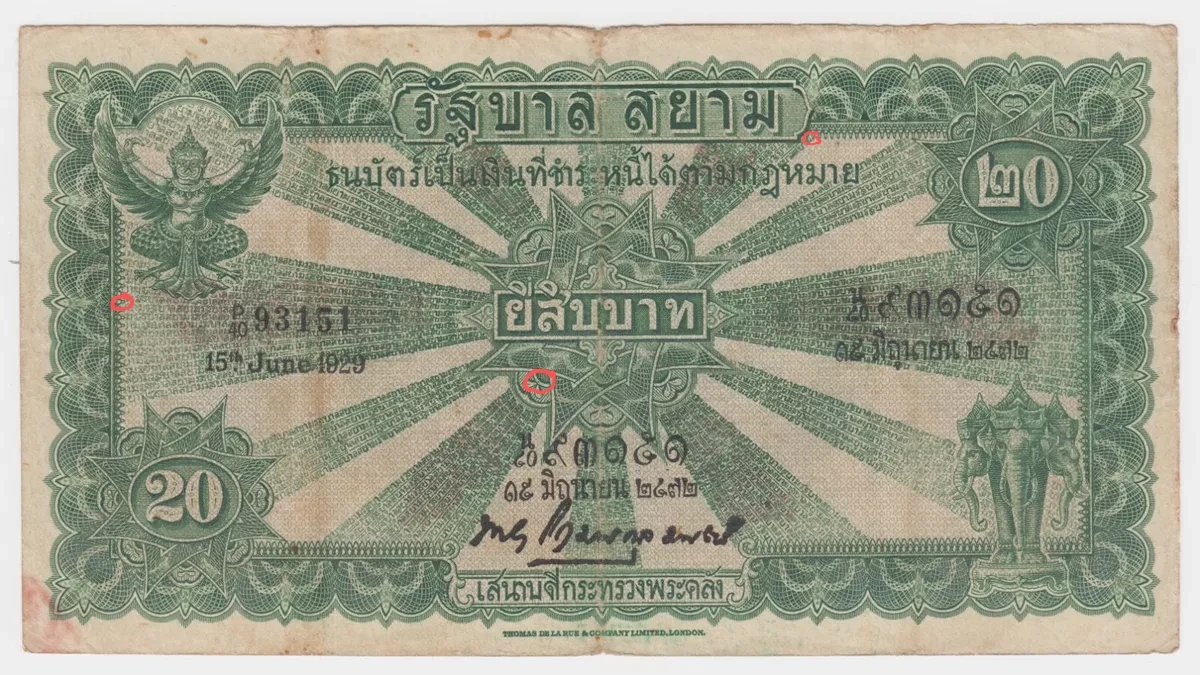





Here are where you can find the secret marks, which have been circled in red (The images aren't clear enough to display close-ups of the marks, but if you have them in your collection, you can use a magnifying glass).
My ranking for this series is 6.5/10. Out of all the series and major varieties, this one stands at 17th place.